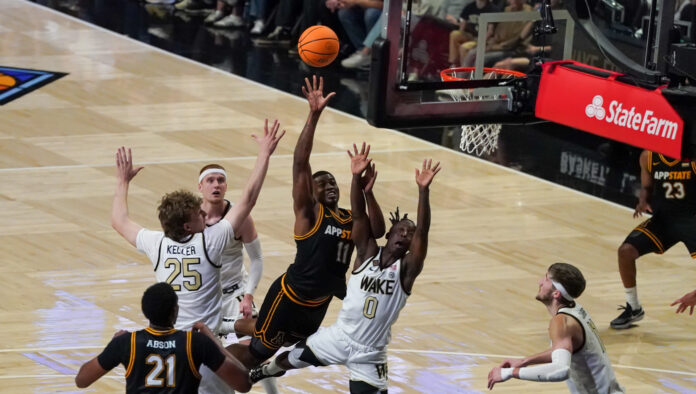By David Rogers. WINSTON-SALEM, N.C. — Covering the National Invitation Tournament (NIT) first round game between No. 1 seed Wake Forest and Appalachian State on March 20, afterwards I couldn’t help but reflect on an experience in the mid-1980s when I was coaching rugby, in Chicago.
Perhaps the biggest sin that a game official or referee can commit is to come into a game thinking that one of the teams is better than the other, right from the get-go.
In Chicago, I had taken on the task of rebuilding a C Division team that had eight or nine players practicing twice a week under a single street lamp in Lincoln Park. About 50 yards away, a Midwest Senior League team, the Chicago Lions, practiced under a couple of big softball lights with about 40 athletes under their broad illumination.
While only eight guys on the team I was taking on came to practice, on game days nearly 30 guys showed up, many of them expecting to play on the A side. That was the culture I inherited.
Well, I had a formula for managing a rugby club that had worked during my early days coaching in California. First, I emphasized attention on the “B” side’s development because that created competition for the “A” side players. Second, if for whatever reason you didn’t or couldn’t make practice, it was next man up. In other words, the “B” side player in your position got an opportunity to play on the “A” side. I didn’t care why you had to miss practice or if you were the team’s star player. It was next man up. The team is bigger than the individual.
And it worked. Within three weeks we had more than 30 guys at practice and I had to petition Chicago Parks & Recreation to light up at least one softball standard for us, which they did. A year later, we peaked with 85 athletes at practice and we had five softball light standards illuminating the field. The Chicago Lions still had their 40 or so players, but were left wondering where all the players came from across the way. They were even more astonished upon finding out that we jumped from C Division to Midwest Senior League in just one year. They were going to have to play us.
I mention all of this because in short order that first year, my rugby club was no longer the doormat of the C Division. We won our first two games and looked forward to the third match against a team from Indiana.
But come game day, it seemed like we were playing against not only the 15 players on the field for the Indiana team but also against the referee. As a former rugby ref, I was slow to criticize because it is often a thankless job. And yet, this young referee was letting the Indiana players come at us from clear offsides positions at every opportunity.
At halftime, I couldn’t contain myself. I walked out to the referee and asked him what he was seeing when he should have been whistling for offsides.
His reply was telling. “The Indiana team is simply better than your team.”
For me, it was an astonishing admission. He had come into the match predisposed to the idea that the Indiana team was a superior competitor, unaware that the former C Division doormat was undergoing a competitive resurrection. And he let that bias allow him to favor the Indiana team. They should win because they were better to start with, he thought.
I was reminded of this referee’s bias while covering the App State-Wake Forest basketball game. I rarely am critical of game officials, but the three referees working the court seemed to have an obvious bias toward Wake Forest, the ACC contender. The fouls being called were one-sided. By game’s end, Wake Forest had been awarded 31 free throws to App State’s eight from the charity stripe. Even if you take away the four fouls called against the Mountaineers in the last minute, it is still a lopsided bias of about 24-8.
How is it possible that App State, who has the fourth lowest number of fouls per game over the course of the season among the 351 schools playing Division I basketball, could have suddenly turned so “criminal”? And that season average includes the outlier number vs. Wake Forest, which pushed the average a bit higher than before.
The bias by these game officials may not have been intentional. That said, at least two of the officials had previous ties to the ACC and Wake Forest at different times in their officiating careers. Just about everyone knows that both the ACC and Wake Forest have storied histories in college basketball. The Sun Belt Conference and App State are relative newcomers to good basketball and surely not the equals of the ACC and Wake Forest, right? That is why the Sun Belt only gets one bid to the NCAA tournament. The SBC teams are not the equal of the ACC schools, which have five schools invited to the “Big Dance.”
So the critical question is somewhat obvious: Did these officials come into the game with a bias toward the ACC and Wake Forest, whether intentional or subconscious? Awarding 19 more free throws to the Demon Deacons in what turned out to be an 11-point game might hint that it is so. Did these officials not know that App State won 27 games this year and one of them was the eventual SEC tournament winner, Auburn.
Because not every foul called sends the other team to the charity stripe, it is important to note that App State was flagged 20 times, almost double their season average, while Wake Forest was whistled 13 times. One Mountaineer player fouled out in the second half and three other starters spent significant time on the bench, in foul trouble, which presumably gave the Demon Deacons that much more of an on-court advantage. Their starters (best players?) hardly ever left the floor.
There was one other telling stat, too: App State’s bench players (the non-starters) outscored Wake Forest’s bench, 36-0. If three (and arguably four) of the starting five were in foul trouble, that gave more scoring opportunities to the Mountaineer reserves. The question of course becomes, how many more or less points would the affected starters have scored if they had been on the court instead of sitting?
To be sure, App State had other problems of their own making, such as making good on only seven of 27 three-point attempts (25.9 percent) and being outrebounded, 39-31. But I am still left wondering what this NIT first round game outcome would have been (A) on a neutral court and (B) with a different set of game officials.





